Adrien Maglo
SoccerNet 2023 Challenges Results
Sep 12, 2023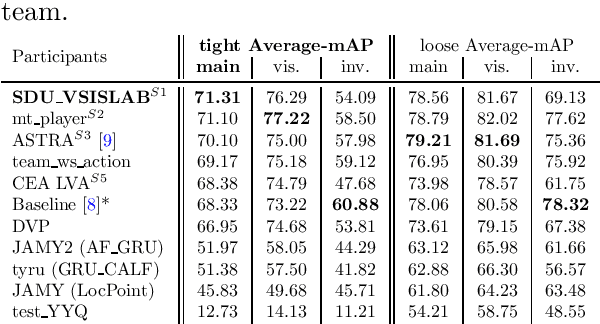


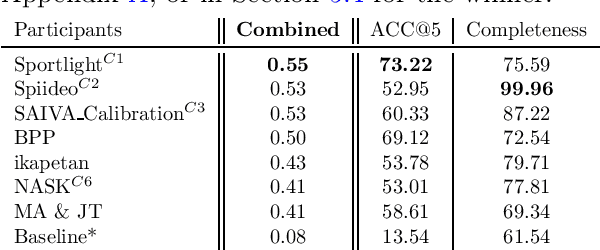
Abstract:The SoccerNet 2023 challenges were the third annual video understanding challenges organized by the SoccerNet team. For this third edition, the challenges were composed of seven vision-based tasks split into three main themes. The first theme, broadcast video understanding, is composed of three high-level tasks related to describing events occurring in the video broadcasts: (1) action spotting, focusing on retrieving all timestamps related to global actions in soccer, (2) ball action spotting, focusing on retrieving all timestamps related to the soccer ball change of state, and (3) dense video captioning, focusing on describing the broadcast with natural language and anchored timestamps. The second theme, field understanding, relates to the single task of (4) camera calibration, focusing on retrieving the intrinsic and extrinsic camera parameters from images. The third and last theme, player understanding, is composed of three low-level tasks related to extracting information about the players: (5) re-identification, focusing on retrieving the same players across multiple views, (6) multiple object tracking, focusing on tracking players and the ball through unedited video streams, and (7) jersey number recognition, focusing on recognizing the jersey number of players from tracklets. Compared to the previous editions of the SoccerNet challenges, tasks (2-3-7) are novel, including new annotations and data, task (4) was enhanced with more data and annotations, and task (6) now focuses on end-to-end approaches. More information on the tasks, challenges, and leaderboards are available on https://www.soccer-net.org. Baselines and development kits can be found on https://github.com/SoccerNet.
SoccerNet 2022 Challenges Results
Oct 05, 2022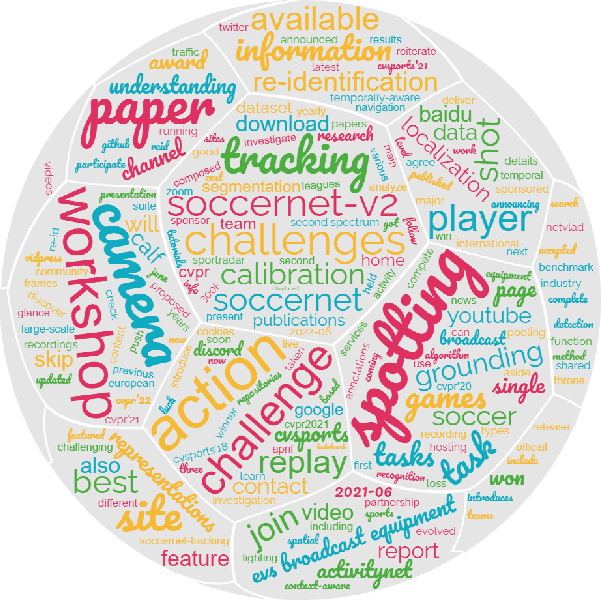



Abstract:The SoccerNet 2022 challenges were the second annual video understanding challenges organized by the SoccerNet team. In 2022, the challenges were composed of 6 vision-based tasks: (1) action spotting, focusing on retrieving action timestamps in long untrimmed videos, (2) replay grounding, focusing on retrieving the live moment of an action shown in a replay, (3) pitch localization, focusing on detecting line and goal part elements, (4) camera calibration, dedicated to retrieving the intrinsic and extrinsic camera parameters, (5) player re-identification, focusing on retrieving the same players across multiple views, and (6) multiple object tracking, focusing on tracking players and the ball through unedited video streams. Compared to last year's challenges, tasks (1-2) had their evaluation metrics redefined to consider tighter temporal accuracies, and tasks (3-6) were novel, including their underlying data and annotations. More information on the tasks, challenges and leaderboards are available on https://www.soccer-net.org. Baselines and development kits are available on https://github.com/SoccerNet.
KaliCalib: A Framework for Basketball Court Registration
Sep 16, 2022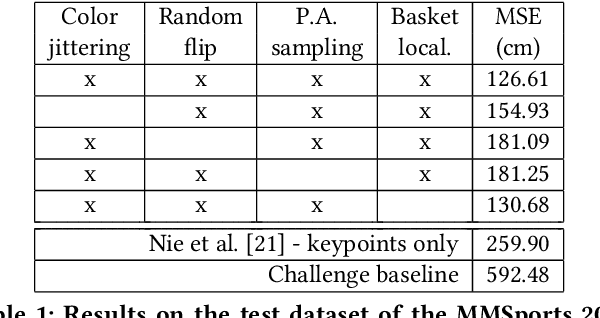

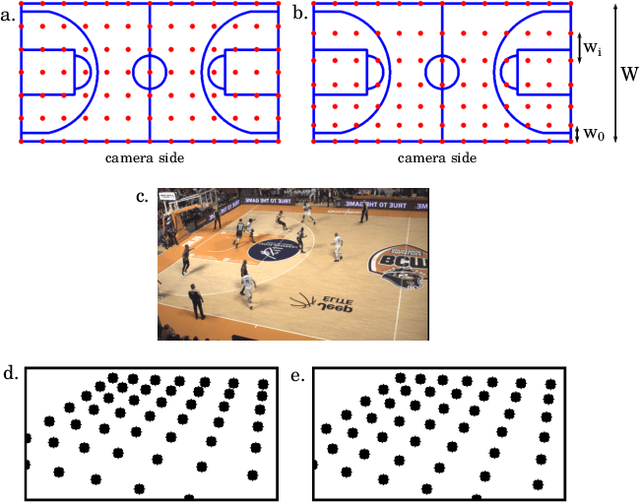
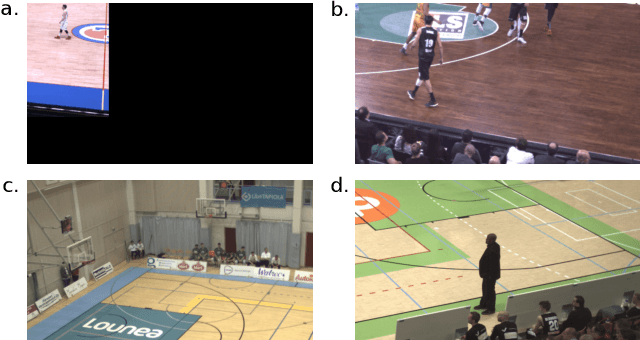
Abstract:Tracking the players and the ball in team sports is key to analyse the performance or to enhance the game watching experience with augmented reality. When the only sources for this data are broadcast videos, sports-field registration systems are required to estimate the homography and re-project the ball or the players from the image space to the field space. This paper describes a new basketball court registration framework in the context of the MMSports 2022 camera calibration challenge. The method is based on the estimation by an encoder-decoder network of the positions of keypoints sampled with perspective-aware constraints. The regression of the basket positions and heavy data augmentation techniques make the model robust to different arenas. Ablation studies show the positive effects of our contributions on the challenge test set. Our method divides the mean squared error by 4.7 compared to the challenge baseline.
Efficient tracking of team sport players with few game-specific annotations
Apr 08, 2022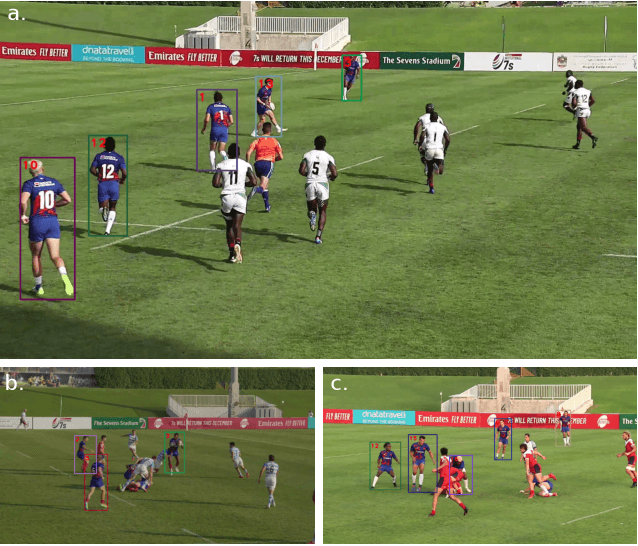
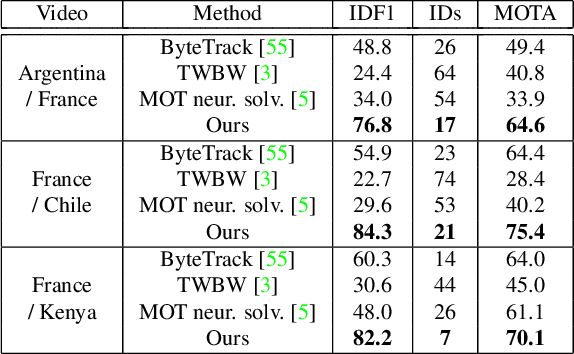
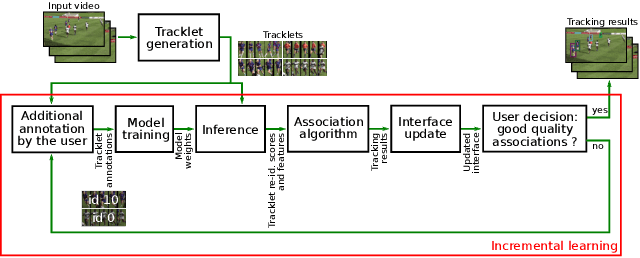
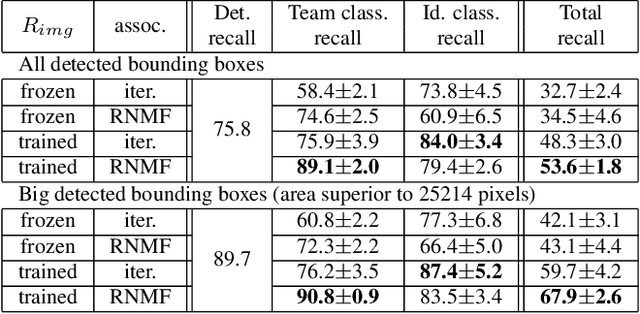
Abstract:One of the requirements for team sports analysis is to track and recognize players. Many tracking and reidentification methods have been proposed in the context of video surveillance. They show very convincing results when tested on public datasets such as the MOT challenge. However, the performance of these methods are not as satisfactory when applied to player tracking. Indeed, in addition to moving very quickly and often being occluded, the players wear the same jersey, which makes the task of reidentification very complex. Some recent tracking methods have been developed more specifically for the team sport context. Due to the lack of public data, these methods use private datasets that make impossible a comparison with them. In this paper, we propose a new generic method to track team sport players during a full game thanks to few human annotations collected via a semi-interactive system. Non-ambiguous tracklets and their appearance features are automatically generated with a detection and a reidentification network both pre-trained on public datasets. Then an incremental learning mechanism trains a Transformer to classify identities using few game-specific human annotations. Finally, tracklets are linked by an association algorithm. We demonstrate the efficiency of our approach on a challenging rugby sevens dataset. To overcome the lack of public sports tracking dataset, we publicly release this dataset at https://kalisteo.cea.fr/index.php/free-resources/. We also show that our method is able to track rugby sevens players during a full match, if they are observable at a minimal resolution, with the annotation of only 6 few seconds length tracklets per player.
 Add to Chrome
Add to Chrome Add to Firefox
Add to Firefox Add to Edge
Add to Edge